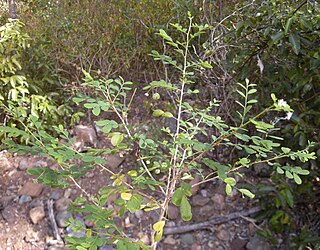
The genus Sauropus, of the family Phyllanthaceae, comprises about 40 species of herbs, shrubs or subshrubs, sometimes with woody bases. These plants can be monoecious or dioecious. They are distributed in Southeast Asia, Malesia and Australia.

Oplismenus is a small genus of annual or perennial grasses, commonly known as basketgrass, found throughout the tropics, subtropics, and in some cases, temperate regions of the Americas, Africa, Asia, and Australia. The systematics of the genus are unclear, with over 100 described species, only 7 species are officially recognized as of 2016.

Tubulicrinis is a genus of crust fungi in the family Hymenochaetaceae. The genus was circumscribed by Dutch mycologist Marinus Anton Donk in 1956.

Pilumnus hirtellus, the bristly crab or hairy crab, is a species of European crab. It is less than 1 inch (25 mm) long and covered in hair. It lives in shallow water and feeds on carrion.
Eviphididae is a family of mites in the order Mesostigmata.
Eviphis is a genus of mites in the family Eviphididae. There are about five described species in Eviphis.
Cercomegistidae is a family of mites in the order Mesostigmata.
Eviphis ostrinus is a species of mite in the family Eviphididae. It is found in Europe.
Eviphis pyrobolus is a species of mite in the family Eviphididae.
Cancricepon elegans is a species of isopods that parasitises the crab Pilumnus hirtellus. It was originally described from French waters and has since been found off the coast of Great Britain.

Phymatodes is a genus of beetles in the family Cerambycidae, containing the following species:
Trichoxys is a genus of beetles in the family Cerambycidae, containing the following species:

Pardaleodes sator, the scarce pathfinder skipper, is a butterfly in the family Hesperiidae. It is found in Sierra Leone, Guinea, Liberia, Ivory Coast, Ghana, Togo, Nigeria, Cameroon, Gabon, the Republic of the Congo, the Central African Republic, Angola, the Democratic Republic of the Congo, Sudan, Uganda, Kenya and Tanzania. The habitat consists of forests.

Oplismenus hirtellus is a flowering perennial plant from the family Poaceae that can be found on every continent in the world except Antarctica, growing mostly in coastal tropic and subtropic regions as well as tropical and subtropical islands such as Hawaii, New Zealand, Australia and Madagascar.

Oplismenus undulatifolius, commonly known as wavyleaf basketgrass, is a species of perennial grass from the family Poaceae that is native to Eurasia, specifically Southern Europe through Southern Asia. Due to its invasive nature, it can be found in countries such as Pakistan, China, Japan, Korea, India, Australia, South Africa, and has since been introduced to the Mid-Atlantic United States. There are no recognized subspecies in Catalogue of Life.

Paniceae is a large tribe of the subfamily Panicoideae in the grasses (Poaceae), the only in the monotypic supertribe Panicodae. It includes roughly 1,500 species in 84 genera, primarily found in tropical and subtropical regions of the world. Paniceae includes species using either of the C4 and C3 photosynthetic pathways, as well as presumably intermediate species. Most of the millets are members of tribe Paniceae.
Phymatodes hirtellus is a species of beetle in the family Cerambycidae.
Trichoxys hirtellus is a species of beetle in the family Cerambycidae. It was described by Chevrolat in 1860.

Phyllanthus hirtellus is a species of flowering plant in the family Phyllanthaceae. It is a miniature heath shrub, growing in erect or sprawling form. Stems are up to 30 cm long, leaves under 8 mm long. It is commonly found in heath or dry woodland in eastern Australia. The specific epithet hirtellus is derived from Latin, meaning finely hairy.









